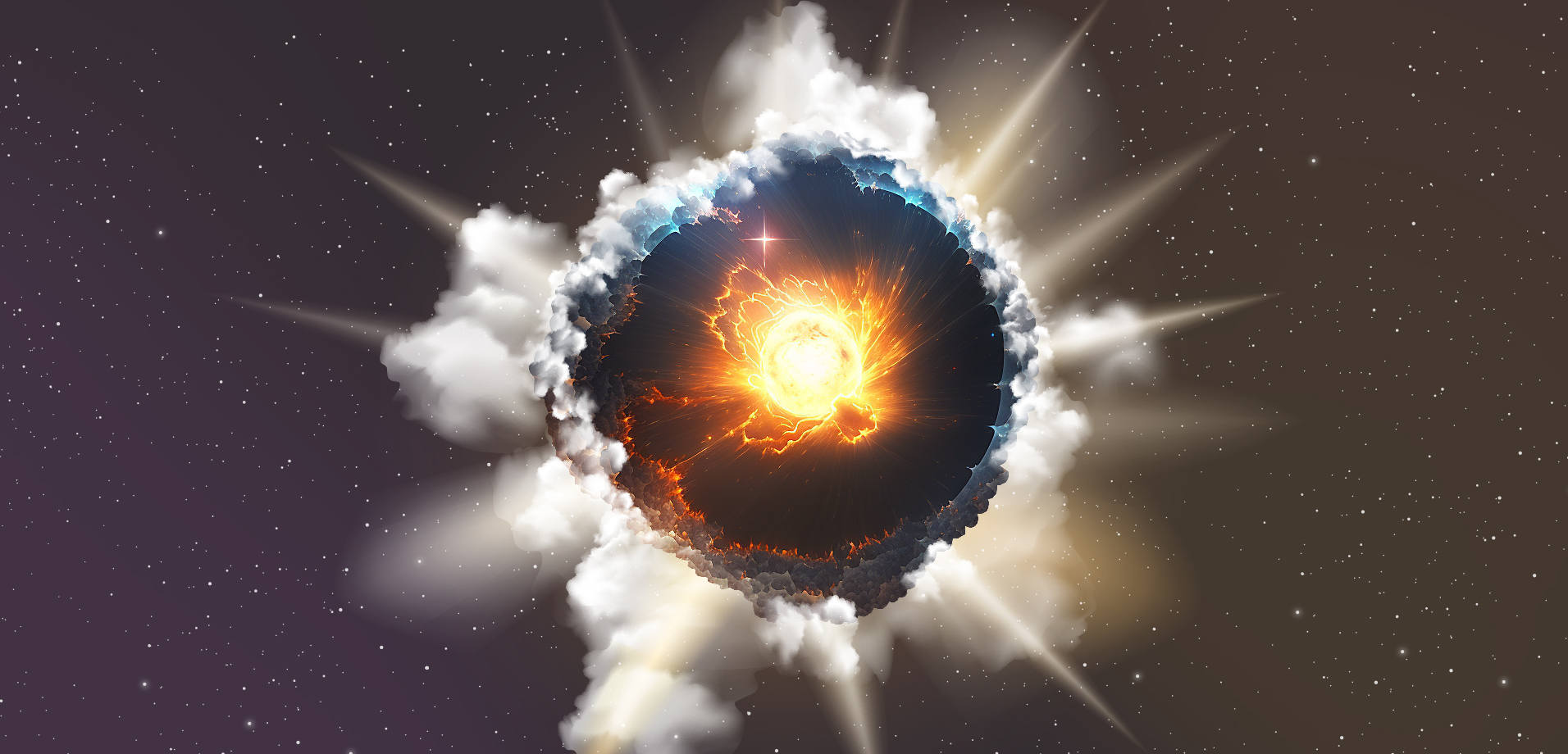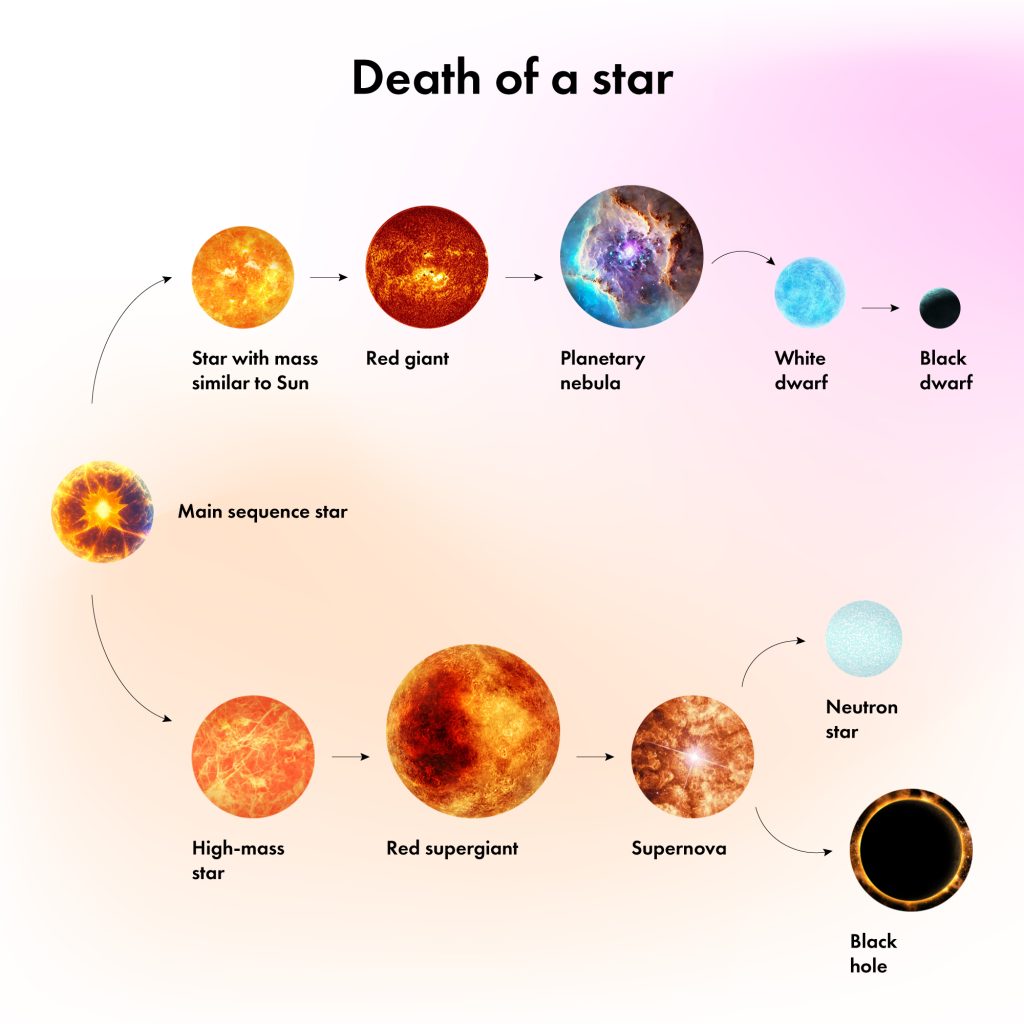Beyond eternity: What happens when a star dies?
18th May 2023
The stars abundantly covering the night sky seem eternal. But it’s not so. They are mortal like everything else in this universe. But how do stars die, and what happens when a star dies? There are several possibilities depending on a size of a star, so, let’s have a closer look!
Scenario 1. What happens when a small star dies?
Each star is a luminous celestial body of gas and chemicals formed by a dust cloud. Stars glow because they undergo thermonuclear reactions of hydrogen and helium. This stable period takes up most of the star’s life cycle and can last tens of billions of years.
So what happens next? How do stars die? The hydrogen fuel in the core runs out, and they cease to exist. The final stage of the star’s life depends on its mass — that is, the amount of matter in which chemical reactions take place. If the mass of the star is the same as that of our Sun (yellow dwarf) or slightly more, the celestial body goes through three stages of transformation.
What are the 3 things that can happen when a star like the Sun dies?
After the hydrogen has run out, the following happens:
- The star expands and turns into a red giant.
- The star sheds its outer shell of gas and dust. What happens to the outer layer of a star when it dies? The shell dissipates and forms a planetary nebula around the remnants of the celestial body’s core.
- The remaining core turns into a very dense but very small object. Such a celestial object is called a white dwarf.
Scenario 2. What happens when a big star dies?
The main question is, do bigger stars die differently? In space, there are many stars that have a mass several times greater than our Sun. Large stars consume hydrogen faster than lighter celestial bodies. Their period of stable glow lasts not billions but millions of years. And the final life stages of a dying large star are different from the life stages of relatively small luminaries.
When a large star runs out of hydrogen, it greatly increases in size and becomes a red supergiant. And then, a spectacular destruction of the star takes place. The core collapses, heats up and explodes. The outer layers are ejected into space with great energy. So what is it called when a star dies? This explosion is called the birth of a supernova.
The explosion’s brightness exceeds the star’s initial glow by 4-8 times. The amount of energy released is about the same as the Sun produces in its entire life. The remaining core gradually shrinks and, depending on its size, becomes either a neutron star or a black hole.
Scenario 3. What happens when a binary star dies?
There are binary systems in the Universe in which two stars are connected by one gravitational field. They orbit around a common centre of mass. The larger star dies first and becomes a white dwarf. The smaller star gradually grows larger and envelops the dead star in gas until all its hydrogen also burns out.
To sum all three scenarios up, we have compiled a visual diagram of the evolution of stars.

What can dead stars turn into?
Do stars die quickly or slowly does not affect their glowing period — meaning, stars glow throughout their entire lifespan. Gradually, the intensity of the glowing decreases, though. The time always comes when the white dwarf cools, fades, and turns into a tiny dim black dwarf.
A supernova also emits light, but if its core is 1.5-3 times larger than the Sun, then after some time, it shrinks and turns into a neutron star, consisting of electrons and heavy atomic nuclei. At the moment of birth, a neutron star glows at a high temperature, but such stars cool down rather quickly and fade away.
So when a star dies, does it disappear? Well, yes. When a white dwarf turns black, the star dies completely, and we can no longer see it in the sky. In the case of a supernova, with its core mass three or more times larger than the mass of the Sun, it transforms into a black hole. This area is so dense that it completely absorbs light, leaving no chance of observing it.
Can a dead star be reborn?
No. But it can serve as the basis for the birth of a new star. During a supernova explosion, not only a large amount of energy is released into outer space, but also huge volumes of incandescent materials, which, under the impact of a shock wave, can form new stars. So if you like to enjoy the starry night landscape, there is no need to worry. The empty black sky overhead is not an actual threat.
How many stars are already dead?
Scientists believe that there are about 200 sextillion stars in space. This is about ten times the amount of water in all the water bodies of the Earth if measured in glasses. It is hard to say how many stars died because the process of the emergence and disappearance of celestial bodies is constant and endless.
Can you see when a star dies?
Stars smaller or slightly larger than the Sun die quietly, and one day we notice only a dim dot instead of a bright star, or we don’t find it at all in the sky at all, which is why we can only speculate about what happens to a star when it dies. But the explosion of a supergiant can be observed. For example, in 2006, the star that exploded in the supernova SN 2006gy in the galaxy NGC 1260 had a mass greater than the Sun by 150 times and was noticed by Robert Quimby and P. Mondol through a telescope.
Are stars dying suns?
Yes and no. After all, the Sun is also a star. We simply learned about it sooner than about others because it is closest to our Earth. Because the Sun is classified as a yellow dwarf, it will have the same star death as other small stars.
It will expand, turn into a red giant, and absorb the inner planets: Mercury, Venus, Earth, and Mars. Then the mass of the Sun will become even larger, and it will be even more difficult to preserve layers of gas and dust. Presumably, the outer layers will eject into space, forming the bright glow of a planetary nebula, and then the remaining core will turn into a white dwarf, after — into a black one. According to scientists, the whole process will take about ten billion years. But all life on Earth will die much earlier than that.
What happens to planets when a star dies?
There are two scenarios of what happens to a planet when its star dies. At the moment of the supergiant explosion, its planets are burned and fly away into outer space. If the star is small, and the explosion does not happen, then the planets may remain in the orbit of the dead star — a white dwarf, but these planets will eventually freeze. The Earth probably falls under the second category.
Final thoughts
So, how do stars die, what happens when a star dies, and do we need to worry about it? Stars explode and die, new stars flare up in their place, and this happens all the time. This process cannot be called the slow death of the Universe. On the contrary, it is its evolution.
As far as our safety is concerned, scientists assure us that there is nothing to worry about now. Our Sun is expanding, but it will take millions of years for it to heat the Earth enough to kill all life on it, whereas other stars are too far away to pose a danger. So the only real threat to us is ourselves, polluting our planet and its orbit with tons of garbage. So, it’s high time to think about cleaning up. Because the stars aren’t going anywhere.






Thank you for your comment! It will be visible on the site after moderation.